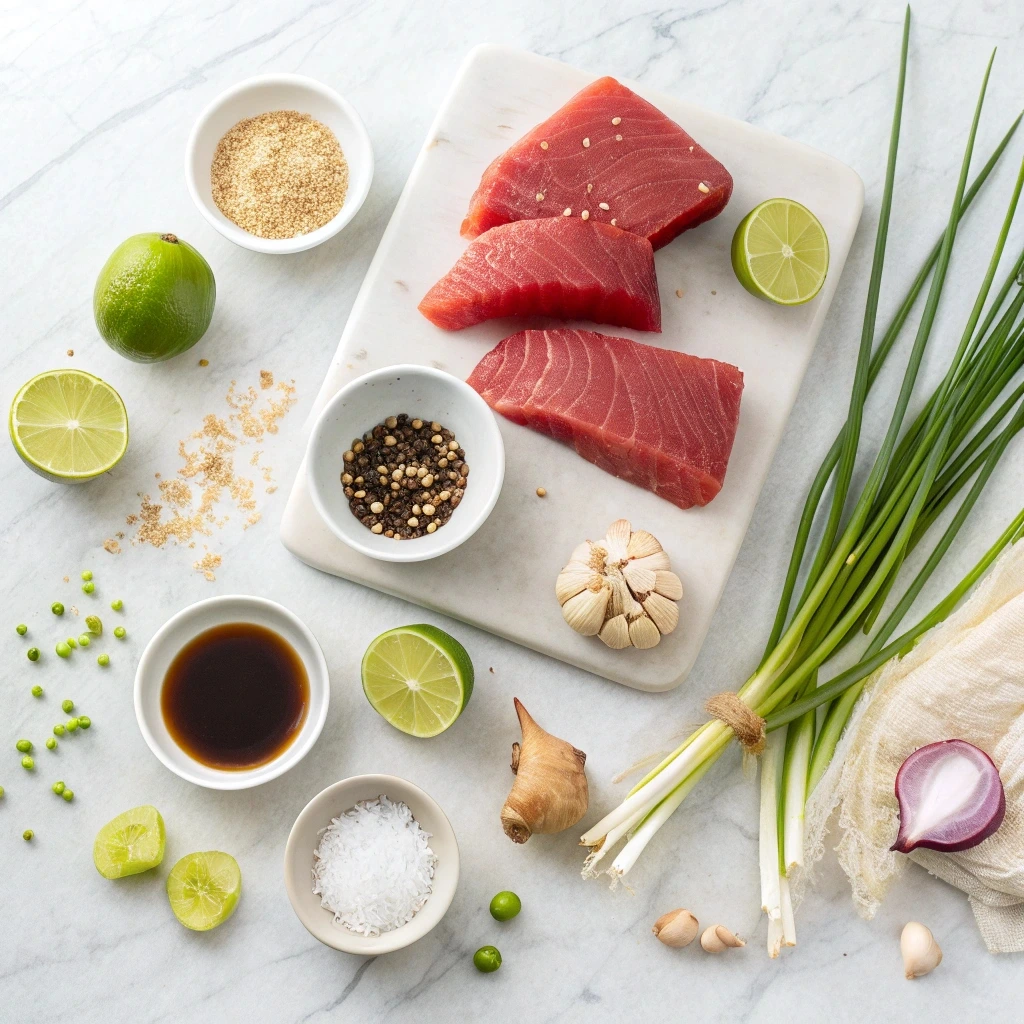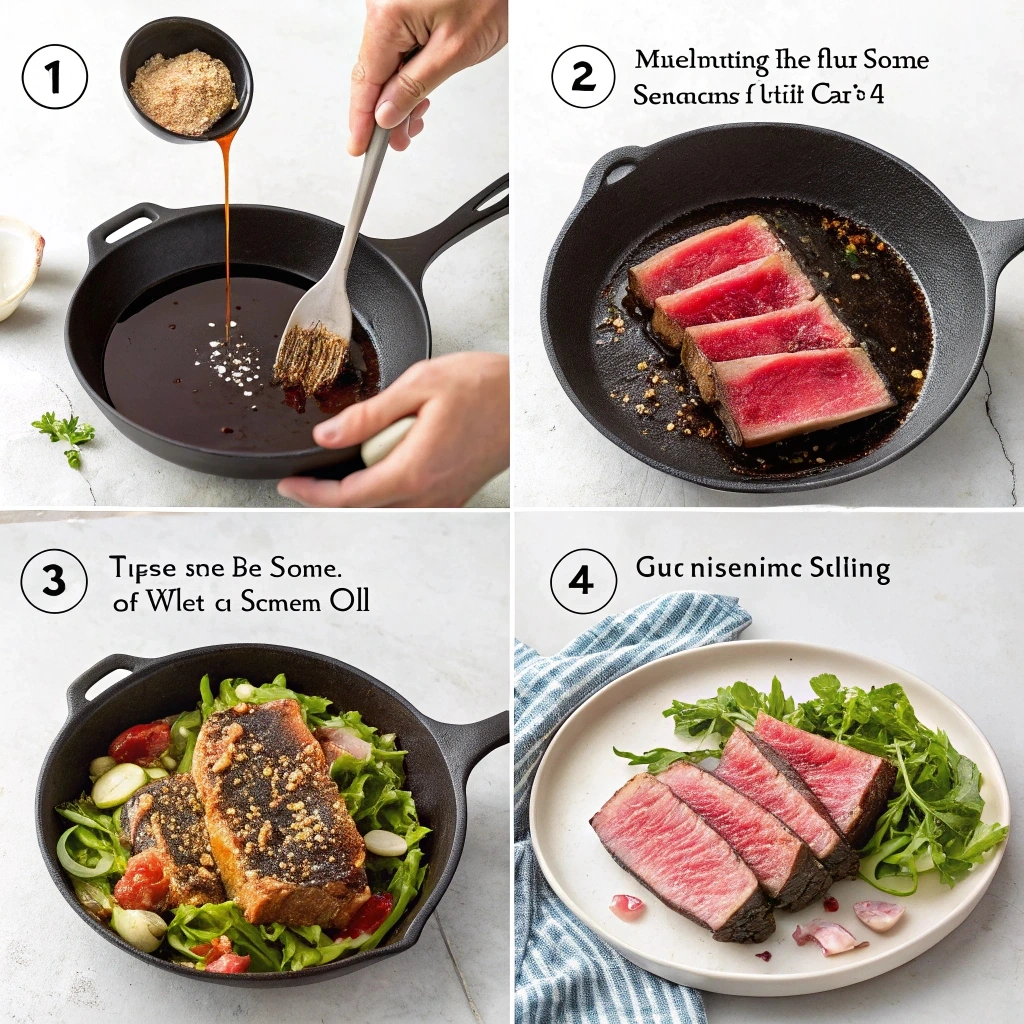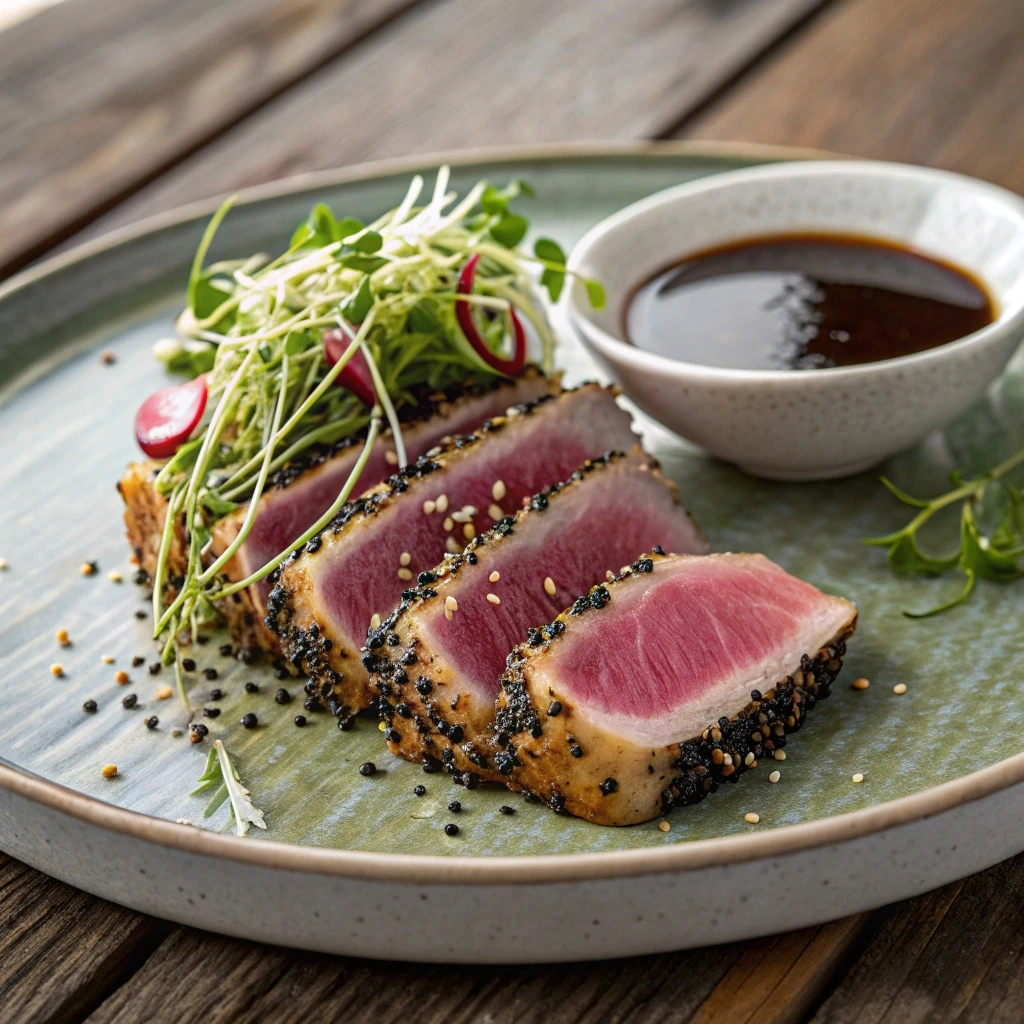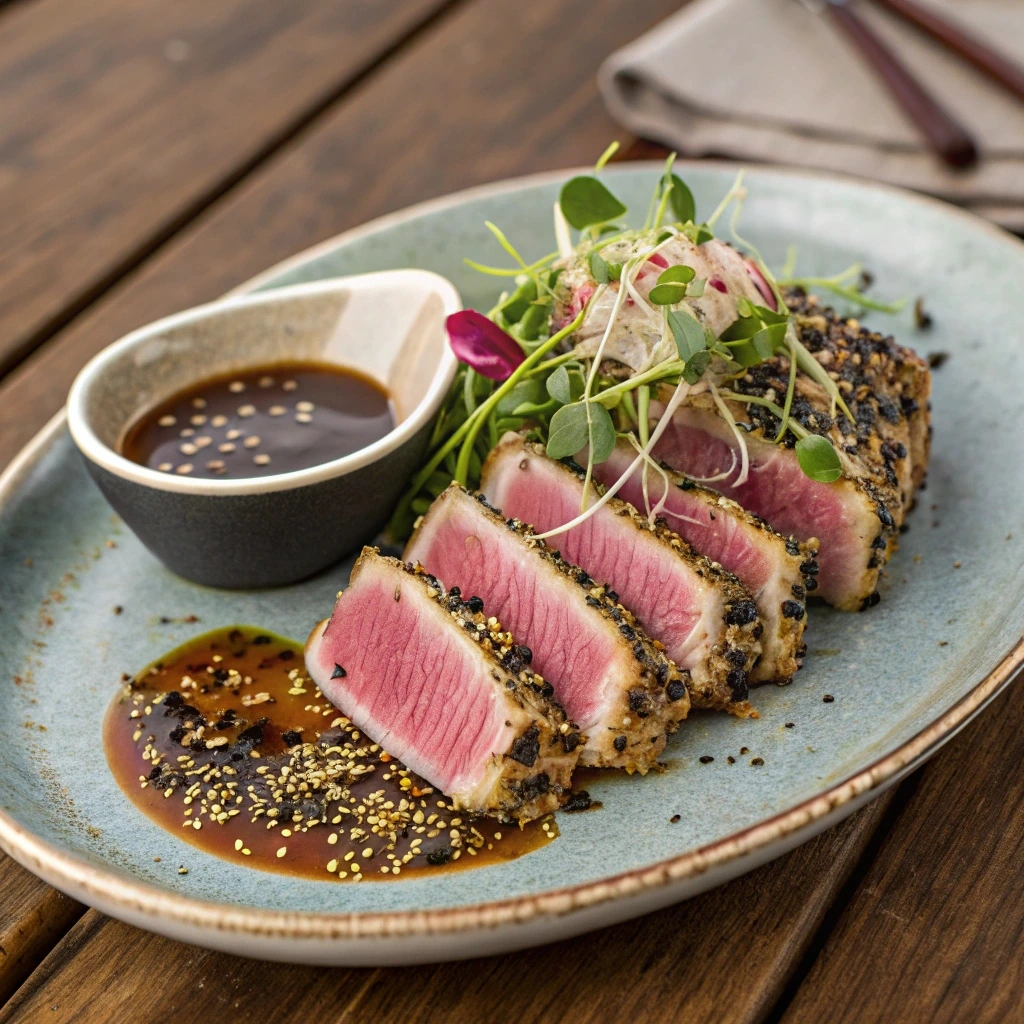There’s something irresistibly elegant about a well-seared ahi tuna steak. It’s one of those dishes that walks the line between simplicity and sophistication. Whether you’ve had it as sashimi, a steak, or in a vibrant poke bowl, ahi tuna (also known as yellowfin tuna) has a delicate flavor and a melt-in-your-mouth texture that’s hard to beat.
In this comprehensive guide, we’ll break down everything you need to know to master the perfect ahi tuna recipe right in your own kitchen. We’ll talk about how to choose the right fish, the best marinades to infuse flavor, and the precise cooking techniques that yield restaurant-worthy results. Plus, we’ll dive into variations, answer FAQs, and serve up expert tips that’ll level up your culinary game.
So if you’ve ever wondered how chefs nail that perfect pink center while keeping the outside seared just right — you’re in for a treat!
Table of Contents
Introduction to Ahi Tuna Recipes
What Is Ahi Tuna and Why Is It Popular?
Ahi tuna, also called yellowfin tuna, is a firm, lean fish known for its deep pink flesh and mild flavor. Unlike some fish that need heavy seasoning or sauces, ahi tuna shines best when treated with a light touch. You’ll often find it featured in dishes like sushi, poke bowls, or as a seared tuna steak served with rice or greens.
But what makes it truly special? For starters, its versatility. You can slice it raw into sashimi, grill it, sear it, or marinate it for a punch of flavor. It adapts well to Asian-inspired tuna recipes, Mediterranean styles, and even spicy Southwest flavors. Moreover, it’s quick to cook—just a minute or two on each side—and can go from fridge to plate in under 15 minutes.
That speed and flexibility make it a weeknight dinner hero. But here’s the kicker: it looks and tastes like something you’d pay top dollar for at a high-end restaurant.
Health Benefits of Ahi Tuna
Aside from its delicious flavor, ahi tuna packs some serious health perks. It’s loaded with high-quality protein, omega-3 fatty acids, and key nutrients like selenium, vitamin D, and potassium. These nutrients support heart health, brain function, and overall wellness.
However, because tuna is a larger fish, it’s best to enjoy it in moderation due to mercury content—especially for pregnant individuals. But for most people, it’s a smart, nutrient-dense choice that’s both satisfying and nourishing.
Choosing the Best Ahi Tuna
Understanding Sushi-Grade Ahi Tuna
Before you dive into any Ahi Tuna Recipe, it’s crucial to start with the right fish. Sushi-grade ahi tuna—also called yellowfin tuna—is the gold standard. But what does “sushi-grade” actually mean?
It’s not an official certification, but rather a term used by reputable fishmongers to indicate that the fish is safe to eat raw. Therefore, if you plan to sear it lightly or serve it rare (as most ahi tuna dishes are), make sure you’re buying fish labeled as sushi-grade or sashimi-grade.
Moreover, look for tuna with a deep red or vibrant pink color and a firm, clean texture. It should smell fresh—like the ocean—not fishy. Frozen tuna is also a safe and high-quality option if it’s flash-frozen immediately after being caught.
Where to Buy Fresh Ahi Tuna Steaks
You can find quality ahi tuna at specialty seafood markets, some grocery stores (like Whole Foods), and even online. However, always check that the seller provides proper cold-chain storage and labeling.
For example, many online retailers offer vacuum-sealed, frozen sushi-grade tuna that’s perfect for home cooks. It’s a convenient way to ensure freshness, especially if you don’t live near a coast.
As a rule of thumb, go for steaks that are about 6 to 8 ounces and ¾ to 1 inch thick. That size ensures a beautiful sear while keeping the inside tender and pink—exactly what you want in a top-notch Ahi Tuna Recipe.
Essential Ingredients for the Perfect Ahi Tuna Recipe

Key Ingredients: Soy Sauce, Sesame Oil, and More
Creating a mouthwatering Ahi Tuna Recipe doesn’t require a pantry full of rare ingredients. In fact, the magic lies in a handful of bold, balanced flavors that complement—not overpower—the fish.
Here’s a quick table of the essential ingredients and their quantities for a classic marinade:
| Ingredient | Quantity |
|---|---|
| Ahi tuna steaks | 2 (6–8 oz each) |
| Toasted sesame oil | 2 tablespoons |
| Soy sauce (or tamari) | 2 tablespoons |
| Fresh ginger (grated) | 1 tablespoon |
| Garlic (minced) | 1 clove |
| Scallion (sliced) | 1, plus extra for garnish |
| Lime juice | 1 teaspoon |
This base marinade gives the tuna a rich, umami flavor with a zesty, aromatic kick. The soy sauce adds saltiness, while the sesame oil brings nutty depth. Meanwhile, ginger and garlic create a warm, spicy undertone that lingers beautifully on the palate.
Optional Add-ins: Spices, Herbs, and Marinades
To add a little heat or a unique twist, you can customize the marinade. For example, try a dash of gochujang, sambal oelek, or even a hint of wasabi. Some cooks like to sprinkle sesame seeds over the steaks for texture and crunch before searing.
Fresh herbs like cilantro or Thai basil can also elevate the flavor profile—especially if you’re pairing the tuna with an Asian-style salad or rice bowl.
With just a few tweaks, your Ahi Tuna Recipe can go from simple to spectacular without a lot of extra effort.
for more recipes :
How to Marinate Ahi Tuna
Basic Marinade Recipe and Preparation Steps
Marinating is the heart of any great Ahi Tuna Recipe. It’s where flavor meets finesse—and it couldn’t be easier. A well-balanced marinade infuses the fish with umami, heat, and a touch of brightness that enhances its natural taste without overwhelming it.

To begin, mix the following ingredients in a shallow dish:
| Ingredient | Quantity |
|---|---|
| Toasted sesame oil | 2 tablespoons |
| Soy sauce (or tamari) | 2 tablespoons |
| Fresh ginger (grated) | 1 tablespoon |
| Garlic (minced) | 1 clove |
| Scallion (sliced) | 1 whole scallion |
| Lime juice | 1 teaspoon |
Next, pat your ahi tuna steaks dry and place them in the marinade. Coat each piece thoroughly. Cover and refrigerate for at least 30 minutes—but ideally, let them marinate for one hour. This gives the flavors time to sink in while keeping the fish firm.
Tips for Enhancing Flavor
Want a little more kick? Add a spoonful of sambal oelek or a drizzle of chili oil. Prefer something aromatic? Fresh lemongrass or a hint of wasabi can work wonders. Don’t forget: always set aside a bit of marinade before adding the tuna. This saved portion makes a delicious dipping sauce after searing.
And here’s a tasty suggestion—For another seafood favorite that’s big on flavor, check out our Best Salmon Patty Recipe. It’s a great companion recipe if you love fish-based meals with bold seasonings.
Remember, a well-marinated steak is the secret weapon behind every unforgettable Ahi Tuna Recipe.
Cooking Techniques for Ahi Tuna Steaks
How to Sear Ahi Tuna: Step-by-Step Guide
So, your tuna’s marinated and ready—what next? It’s time to master the sear. This part is quick, but timing is everything. Because ahi tuna is best served rare in the center, you’ll only need about 1–1.5 minutes per side.
Here’s how to do it:
- Preheat your skillet – Use a heavy-bottomed pan, ideally cast iron. Heat it over medium-high until it’s smoking hot.
- Add oil – A touch of sesame or avocado oil does the trick.
- Sear the steaks – Gently place the marinated tuna into the hot pan. Cook for about 60–90 seconds on each side. You want a golden crust while keeping the center pink and cool.
- Rest, then slice – Let the steaks rest for 2 minutes. Slice thinly, against the grain.
Voilà! You’ve just created a restaurant-quality dish right at home.
Pan-Searing vs. Grilling vs. Air Frying
While pan-searing is the go-to method, grilling ahi tuna steaks offers a smokier finish. Just be sure to oil the grates and cook over high heat for the same short time.
Alternatively, if you’re a fan of modern tools, an air fryer set to 400°F can cook a tuna steak in just under 4 minutes (2 per side). It’s not traditional, but it’s fast, easy, and mess-free.
Internal Temperature and Doneness Levels
To stay safe and delicious, aim for an internal temp of 90°F–110°F for rare and 115°F–120°F for medium-rare. Use a digital thermometer to avoid overcooking.
And remember: ahi tuna should be pink inside—not gray. That rare center is what sets an Ahi Tuna Recipe apart from an average fish dish.
Serving Suggestions for Ahi Tuna Recipes
Side Dishes That Pair Perfectly
While your Ahi Tuna Recipe can easily shine solo, pairing it with the right side dish takes the meal to the next level. Because ahi tuna has a bold yet clean flavor, it plays well with both vibrant and neutral companions.
For a light and refreshing option, try a shaved fennel salad or a citrus-dressed arugula mix. The crunch and acidity bring balance and contrast to the soft, rich tuna. On the other hand, a bowl of steamed white jasmine rice or coconut rice works wonders as a base, soaking up those flavorful juices.
Additionally, roasted vegetables like asparagus or blistered shishito peppers make fantastic, colorful accompaniments. Want something with an Asian flair? A small serving of sesame noodles or garlic sautéed spinach adds depth without stealing the show.
How to Present Your Tuna Like a Pro
You eat with your eyes first—so presentation matters! Once your tuna is seared and rested, slice it into thin, even pieces using a sharp knife. This not only showcases that stunning pink center but also makes it easier to enjoy.
Arrange the slices in a fan or spiral pattern over a bed of rice or greens. Drizzle leftover marinade or aioli over the top for a glossy finish. Then, sprinkle with scallions, sesame seeds, or even thin strips of nori.
For an extra pop of color and flavor, add pickled red onions or microgreens. And don’t forget a lemon wedge or lime for a final zesty touch.
So, whether you’re serving guests or just treating yourself, the right sides and thoughtful plating can elevate your Ahi Tuna Recipe from great to unforgettable.
Variations of Ahi Tuna Recipes You’ll Love
Spicy Ahi Tuna with Sambal or Chili Oil
If you like your food with a bit of heat, you’re in for a treat. One of the easiest ways to spice up your Ahi Tuna Recipe is by adding sambal oelek or chili oil to the marinade. These spicy additions enhance the natural flavors of the tuna without overwhelming them.
For example, you can mix ½ teaspoon of chili garlic paste into your regular marinade or drizzle chili oil right over the seared tuna. A hint of heat adds complexity and keeps things interesting, especially when paired with a cool side like cucumber salad or mango salsa.
Moreover, you could dust the tuna in crushed red pepper flakes before searing for a crispy, fiery crust.
Garlic Aioli Drizzle and Pickled Onion Garnish
For something smooth and bold, try topping your tuna with a dollop of garlic aioli. It’s creamy, rich, and brings just the right contrast to the firm texture of the tuna. To make a simple aioli, mix together:
- ¼ cup mayonnaise
- 1 minced garlic clove
- 1 teaspoon lemon juice
- A pinch of salt
Blend and chill before serving. Drizzle over the tuna or serve on the side.
To elevate the dish even more, garnish with thin slices of pickled onion. Their bright, tangy flavor cuts through the richness and adds an eye-catching pink hue.
For those who prefer raw preparations, consider turning your seared tuna into a poke bowl. Dice the tuna, toss with sesame oil, soy sauce, and green onions, and serve over rice with toppings like avocado and edamame.
Each of these twists gives your Ahi Tuna Recipe a new identity—while keeping the core idea deliciously intact.
Storing and Reheating Leftover Ahi Tuna
Can You Eat Leftover Ahi Tuna Safely?
Yes, but with some care. Since most Ahi Tuna Recipes involve searing the outside while keeping the inside rare or even raw, storing leftovers properly is essential for both flavor and safety.
If you have extra, store your seared tuna in an airtight container in the fridge. Ideally, you should eat it within 24 hours. After that, the texture begins to change, and it may lose its fresh flavor.
Moreover, avoid freezing seared tuna. While technically safe, freezing often ruins its tender, sashimi-like texture once thawed.
Storage Tips: Fridge, Airtight Containers, and Freezing
To keep your tuna fresh, place it in a shallow container lined with paper towels to absorb moisture. Then, seal it tightly. This helps maintain the texture and prevents it from absorbing other fridge smells.
Reheating? Well, less is more. Tuna can overcook in a flash, so avoid the microwave. Instead, let it come to room temperature or gently warm it in a pan for just a few seconds.
If you’re using the leftover tuna in a salad or bowl, there’s really no need to reheat at all. Simply slice and serve. That’s another reason why an Ahi Tuna Recipe is so perfect for next-day meals—it’s just as tasty cold!

Common Mistakes to Avoid When Cooking Ahi Tuna
Using Low-Quality Tuna
Let’s be real—no matter how good your marinade is, a poor cut of fish will ruin your Ahi Tuna Recipe. One of the biggest mistakes home cooks make is using tuna that isn’t sushi-grade or isn’t fresh enough.
Therefore, always go for sushi- or sashimi-grade yellowfin. Look for deep pink color, firmness, and a fresh ocean scent—not a “fishy” smell.
Cheap, low-quality tuna will not only taste bland but can also be risky to eat if served rare. It’s worth spending a little extra for quality here.
Overcooking or Overseasoning the Tuna
Another common pitfall? Overcooking. Because ahi tuna cooks quickly, just one minute too long can leave it dry and gray instead of pink and buttery.
Likewise, be gentle with seasoning. While bold marinades are great, drowning your fish in soy or oil can overpower its delicate flavor. Let the tuna shine.
Also, don’t forget to pat it dry before cooking—this helps get that perfect golden crust.
In short, treat your tuna like the star it is. With fresh fish, light seasoning, and a short sear, your Ahi Tuna Recipe will hit every note—clean, rich, and incredibly satisfying.
Ahi Tuna Recipe FAQs ‘People Also Ask’
Is Ahi Tuna Safe to Eat Rare or Raw?
Yes, as long as it’s sushi-grade. Since many Ahi Tuna Recipes only lightly sear the outside, the inside often remains rare or raw. Therefore, it’s crucial to use high-quality, sushi-grade tuna. This kind of fish is handled and frozen to reduce the risk of parasites, making it safer to eat undercooked.
However, if you’re unsure about the source, it’s better to fully cook the tuna or use it in dishes that don’t require raw consumption.
What Does Ahi Tuna Taste Like?
Ahi tuna has a mild, meaty flavor with a slightly sweet undertone. Unlike stronger-tasting fish like mackerel or sardines, it’s clean and buttery—especially when served rare.
Because of its subtle taste, it pairs beautifully with soy, citrus, ginger, or sesame. That’s why most Ahi Tuna Recipes lean toward light Asian marinades that enhance rather than overpower.
How Do You Know When Ahi Tuna Is Done?
That depends on how you like it! For rare, the outside should be seared with a bright pink middle. Usually, this means cooking for just 60–90 seconds per side.
If you prefer medium-rare, add another 30 seconds to each side. Use a food thermometer for precision—rare is around 90°F to 110°F internally.
Is Ahi Tuna Healthy for You?
Absolutely. Ahi tuna is rich in protein, omega-3 fatty acids, and essential nutrients like selenium and vitamin D. It supports heart and brain health, and it’s naturally low in calories and fat.
However, because it’s a large fish, limit intake if you’re pregnant or sensitive to mercury. Otherwise, it’s a delicious, health-conscious choice—especially when prepared with a light Ahi Tuna Recipe.
Final Thoughts and Pro Tips for a Perfect Ahi Tuna Dish
Making Extra Marinade for Dipping
Here’s a secret move many pros use: make a little extra marinade before adding your tuna, and set it aside. That way, after you sear your steaks, you’ve got a bold dipping sauce ready to go.
This small step not only adds flavor at the table but also gives your Ahi Tuna Recipe a polished, restaurant-style finish.
Moreover, a drizzle of this sauce over rice or salad can tie your whole plate together. Just make sure you don’t reuse marinade that touched raw fish—always reserve a fresh batch ahead of time.
Using Cast-Iron Skillet for Better Sear
If you want that crispy, golden crust on your tuna, nothing beats a cast-iron pan. It holds heat evenly and gets hot enough to sear fast—without overcooking the inside.
Before placing your tuna in the pan, let it heat up for a few minutes. Add oil, then sear each side for just over a minute. That’s it! With this method, your Ahi Tuna Recipe will deliver that perfect contrast between the warm crust and cool, rare center.
Finally, don’t be afraid to experiment. With simple tweaks, this dish can go spicy, citrusy, garlicky—or all three. The beauty of ahi tuna lies in its versatility, making it one of the most rewarding proteins to cook at home.

